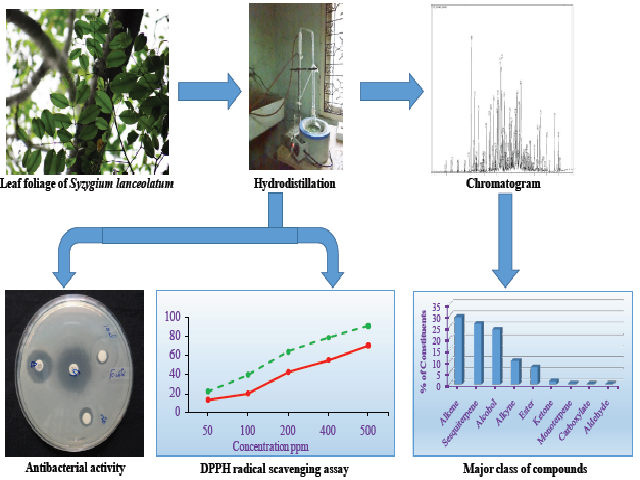Chemical Profiling of Leaf Essential Oil, Antioxidant Potential and Antibacterial Activity of Syzygium lanceolatum (Lam.) Wt. & Arn. (Myrtaceae)
DOI:
https://doi.org/10.5530/fra.2016.1.2Keywords:
ABTS, Antioxidant activity, DPPH, Essential oil, GC-MS, Syzygium lanceolatumAbstract
Introduction: The present study was aimed to analyse the chemical composition, antioxidant potential and antibacterial activity in the leaf essential oil of Syzygium lanceolatum Methods: The essential oil was isolated by hydrodistillation method using a Clevenger type apparatus. The chemical composition of leaf essential oil was analysed by GC-MS. Antioxidant activity was determined by DPPH and ABTS radical scavenging assay. Antibacterial potential was tested against six bacterial strains. Results: GC-MS analysis revealed 2,8-Dimethyl-7-methylene-1,8-nonadien-3-yne (9.77%), Germacrene D (7.45%) as the major constituents and Linalool, β-Selinene (0.03%), Santalol (0.02%) were present in trace amounts. Maximum free-radical scavenging activity (69.97%) was observed at 500 ppm by the essential oil of S. lanceolatum, while the synthetic antioxidant Gallic acid showed 90.93% inhibition at the same concentration. The IC50 value of leaf essential oil and standard gallic acid were 219.24 ± 5.82 ppm and 159.84 ± 2.7 ppm respectively. In ABTS analysis, the oil showed the percentage inhibition in concentration dependent manner. 500 ppm concentration of oil showed 73.01% free-radical inhibition while the gallic acid exhibited 90.4% inhibition. The IC50 value of leaf essential oil and standard were 169.68 ± 3.09 ppm and 217.09 ± 0.70 ppm respectively. Antibacterial activity of leaf essential oil was tested against six bacterial strains and it was effective against all the strains. Conclusion: A total of 106 compounds were identified from the leaf essential oil and alkynes were the major class of compound, followed by the sesquiterpenes. The DPPH radical scavenging assay confirmed the antioxidant potential of the essential oil. Antibacterial activity tests proved that it is a potent growth inhibitor of pathogenic microbes. The present study throws light on the bioactive composition of S. lancoelatum essential oil and further studies will confirm the mode of action of these compounds.
Downloads
Metrics





